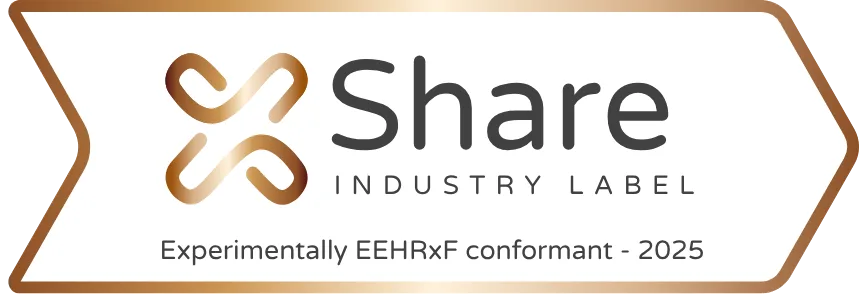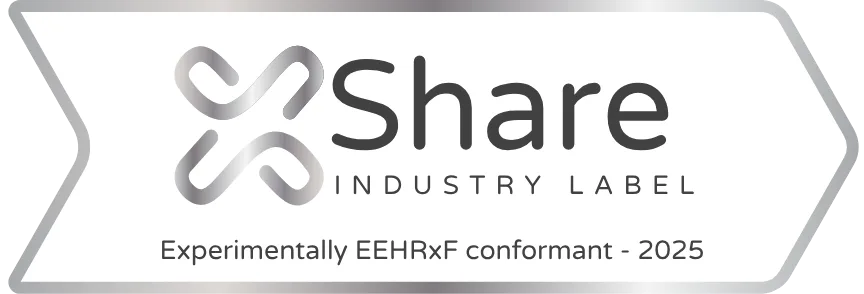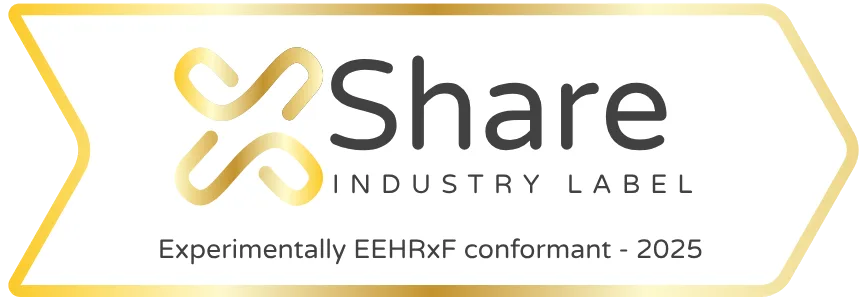The xShare industry label is an experimental, voluntary, pre-regulatory certification designed to help EHR systems and wellness app manufacturers demonstrate their technical readiness for the European Electronic Health Record Exchange Format (EEHRxF). Focused on interoperability, secure data sharing, and patient data portability, the xShare industry label allows manufacturers to validate their solutions against emerging EHDS standards ahead of mandatory EU conformity processes.
Developed collaboratively with industry stakeholders, the xShare industry label acts as a sandbox environment to support companies in navigating key EEHRxFrequirements, preparing for EU Declaration of Conformity (Article 39), participation in digital testing environments (Article 40), and future registration in the official EU registry (Article 49).
The label operates across three progressive levels – Bronze, Silver, and Gold – each reflecting increasing levels of technical maturity, interoperability capacity, and real-world integration.
The bronze label is the entry point into the xShare labelling system, designed to encourage early-stage engagement by lowering the barriers to demonstrating interoperability. At this level, certification is achieved entirely through a self-declared conformance process.
The Bronze level was designed with the requirements of Article 39 of the EHDS in mind, which mandates that manufacturers of EHR systems submit an EU Declaration of Conformity demonstrating alignment with the essential requirements laid down in Annex II of the regulation. This declaration of conformity also needs to be made available in the language where the EHR system is made available. The self-assessment approach of the bronze label directly supports these needs by offering a structured, standardised way to document conformance. It helps manufacturers clarify what to declare, simplifies verification for national authorities, and promotes consistency across member states, streamlining self-declaration processes and contributing to a more level playing field across the EU digital health market.

The Silver label signifies a more advanced stage of interoperability maturity. At this level, systems must demonstrate the ability to both consume and produce EEHRxF-conformant data, establishing bidirectional interoperability and deeper integration into digital healthcare ecosystems. This process involves the use of Gazelle, a testing platform developed by IHE Europe, to validate structured documents such as International Patient Summaries (IPS), using HL7 FHIR and conforming to the xShare implementation guides.
The Silver label was designed with the anticipated needs of Article 40 of the EHDS Regulation in mind, which mandates the creation of digital testing environments to assess compliance with interoperability, security, and performance requirements. This environment aims to simulate real-world conditions for evaluating digital health solutions before deployment. The Silver level process, through its structured use of the Gazelle platform and the IHE Plugathon for in-depth, scenario-based testing, provides a practical model for these future environments. By incorporating both automated and human-led assessments, Silver-level validation offers a blueprint for how such digital testing environments may function effectively in practice, supporting robust technical evaluations aligned with EHDS objectives.

The gold level of the label represents the highest level of xShare certification, designed to recognise organisations that are technically and operationally interoperable and embedded within national or regional digital health ecosystems.
This level was created to highlight solutions that actively shape and support the broader goals of EHDS through standard-setting, public health collaboration, and advanced use cases such as clinical research and international care coordination. This real-world assessment ensures that the solution functions reliably within a regulated healthcare setting.
The manufacturer will need to engage with an officially recognised regional or national authority to demonstrate real-world integration into trusted healthcare networks. The national/regional authority may introduce additional tests.
